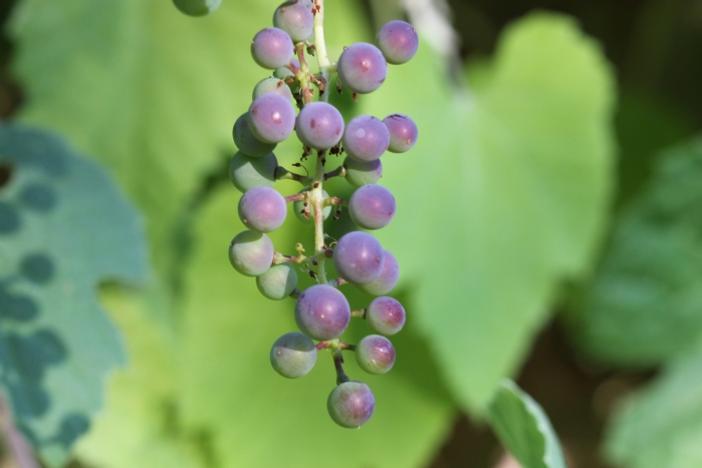Desert Wild Grape
(Vitis giradiana)
Desert Wild Grape (Vitis giradiana)
/
/

Photo by Easyscape
CC BY-SA 4.0
Image By:
Photo by Easyscape
Recorded By:
Copyright:
CC BY-SA 4.0
Copyright Notice:
http://creativecommons.org/licenses/by-sa/4.0/ | CC BY-SA 4.0

















































Estimated Native Range
Summary
Vitis giradiana, commonly known as Desert Wild Grape, is a deciduous perennial vine native to the chaparral, woodlands, and riparian zones of Southern California and Baja California. It can climb to heights of 20-50 feet (6-15 meters) with a similar spread of 20-30 feet (6-9 meters), often draping over other vegetation or structures. The vine produces small, greenish flowers that are not particularly showy, followed by clusters of dark purple grapes that ripen in late summer to fall. The foliage turns yellow in autumn, adding seasonal interest.
Desert Wild Grape is valued for its drought tolerance once established, making it suitable for xeriscaping and naturalistic plantings. It provides habitat and food for wildlife, including birds and butterflies. In gardens, it can be used for arbors, trellises, or to cover fences, offering a lush, green canopy during the growing season. It thrives in a range of soil types, provided they are well-drained, and prefers full sun to partial shade. While generally low-maintenance, it may require pruning to manage its vigorous growth. It is also resistant to many pests and diseases, but can be susceptible to powdery mildew in humid conditions. Culturally, the grapes have been utilized by various Native American tribes for fresh eating, drying into raisins, and fermenting into wine. The sap was traditionally used as a hair treatment.CC BY-SA 4.0
Desert Wild Grape is valued for its drought tolerance once established, making it suitable for xeriscaping and naturalistic plantings. It provides habitat and food for wildlife, including birds and butterflies. In gardens, it can be used for arbors, trellises, or to cover fences, offering a lush, green canopy during the growing season. It thrives in a range of soil types, provided they are well-drained, and prefers full sun to partial shade. While generally low-maintenance, it may require pruning to manage its vigorous growth. It is also resistant to many pests and diseases, but can be susceptible to powdery mildew in humid conditions. Culturally, the grapes have been utilized by various Native American tribes for fresh eating, drying into raisins, and fermenting into wine. The sap was traditionally used as a hair treatment.CC BY-SA 4.0
Plant Description
- Plant Type: Vine
- Height: 20-50 feet
- Width: 20-30 feet
- Growth Rate: Rapid
- Flower Color: N/A
- Flowering Season: Spring
- Leaf Retention: Deciduous
Growth Requirements
- Sun: Full Sun
- Water: Low, Medium
- Drainage: Slow, Medium, Fast
Common Uses
Bee Garden, Bird Garden, Butterfly Garden, Low Maintenance, Rabbit Resistant
Natural Habitat
Native to the chaparral, woodlands, and riparian zones of Southern California and Baja California
Other Names
Common Names:
Scientific Names: , Vitis girdiana, Vitis giradiana,
GBIF Accepted Name: Vitis giradiana Munson